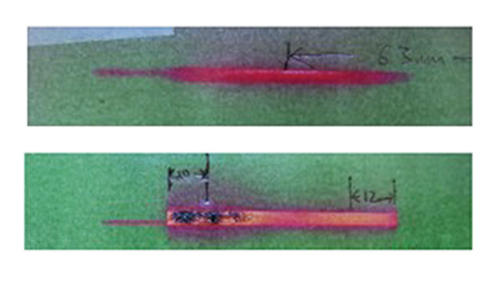X-RAY RUNS: Apply for Beamtime
2017 Nov 1 - Dec 21
2018 Feb 7 - Apr 3
2018 Proposal/BTR deadline: 12/1/17
2018 Apr 11 - Jun 4
2018 Proposal/BTR deadline: 2/1/18
As of October 2014, the three CHESS experimental stations known as G-line joined A1 and A2 in becoming among the first undulator-fed beam lines at CHESS. Thanks to a little luck and a lot of clever engineering, the two, newly-installed canted undulators feed G-line without any modification to the G-line optics. This works because the two undulator beams, which are separated by 1 milliradian, fit almost perfectly within the much wider fan of radiation previously produced by the wiggler. With the wiggler installed, G2 and G3 shared the Northern half of the wiggler fan, while G1 used the Southern half.

Top image shows the the old, G-line wiggler beam obtained by placing burn paper in a position upstream of most of G-line’s optics, in an enclosure normally filled with Helium gas. Bottom image shows two beams, one each from two, prototype undulators canted at 1 milliradian. The two prototype undulators are 1 meter and 0.3 meters long, producing the evident difference in intensity the right and left-hand beams. These prototype undulators were replaced with the design undulators, each 1.5 - meters long, on November 4th and 5th.
An interesting feature of the undulator arrangement at CHESS is that each undulator feeds beamlines in both directions: A-line receives radiation from the electron beam, and G-line receives that from the positrons. Undeniably, this arrangement complicates the scheduling process, since optimal “K” value for the undulator for experiments at G3 and A2 may not necessarily coincide. Fortunately, all G-line nor A-line are primarily used for diffraction, and this new constraint will not seriously impact operations in the short term.
The primary optics for both branches of G-line consist of two pairs of synthetic, W/B4C monochromators, one pair for each of the two branches (G1 on the one hand, and G2/3 on the other). In order to take full advantage of the new sources, an upgrade of the G-line optics is underway. This upgrade will replace the bottom-cooled, SiC substrates now in service with internal-water cooled Si substrates. In addition, toroidal mirrors will replace fixed-curvature sagittal focusing currently performed by the second ML of each branch. Among the impacts of this change will be to substantially improve the flux at the upper limit of G-line’s range at 16 keV (imposed by the first collimating mirror).
With the design undulators in place, tests based on the prototype undulator used for commissioning suggest a substantial increase in flux at G-line. This flux will be very useful for all of the ongoing experimental programs — from BioSAXS at G1, to high resolution XRD at G2, to in-situ studies of many varieties at G3. At G3 in particular, we anticipate well above 1x1014 photons / second in a 1x1 mm2 spot. This flux will be immediately useful for wide variety of applications for which G3 has recently been employed — from in situ thin film growth, to high-speed XRF mapping, to in-situ measurements of strain-wave propagation using fast, integrating pixel array detectors. The extra flux will no doubt also enable other, exciting applications that have yet to be proposed.
Submitted by: Arthur Woll, CHESS, Cornell University
11/05/2014
